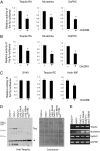Drosophila Orb2 targets genes involved in neuronal growth, synapse formation, and protein turnover
- PMID: 20547833
- PMCID: PMC2900709
- DOI: 10.1073/pnas.1004433107
Drosophila Orb2 targets genes involved in neuronal growth, synapse formation, and protein turnover
Abstract
In the study of long-term memory, how memory persists is a fundamental and unresolved question. What are the molecular components of the long-lasting memory trace? Previous studies in Aplysia and Drosophila have found that a neuronal variant of a RNA-binding protein with a self-perpetuating prion-like property, cytoplasmic polyadenylation element binding protein, is required for the persistence of long-term synaptic facilitation in the snail and long-term memory in the fly. In this study, we have identified the mRNA targets of the Drosophila neuronal cytoplasmic polyadenylation element binding protein, Orb2. These Orb2 targets include genes involved in neuronal growth, synapse formation, and intriguingly, protein turnover. These targets suggest that the persistent form of the memory trace might be comprised of molecules that maintain a sustained, permissive environment for synaptic growth in an activated synapse.
Conflict of interest statement
The authors declare no conflict of interest.
Figures



References
-
- Casadio A, et al. A transient, neuron-wide form of CREB-mediated long-term facilitation can be stabilized at specific synapses by local protein synthesis. Cell. 1999;99:221–237. - PubMed
-
- Frey U, Morris RG. Synaptic tagging and long-term potentiation. Nature. 1997;385:533–536. - PubMed
-
- Kang H, Schuman EM. A requirement for local protein synthesis in neurotrophin-induced hippocampal synaptic plasticity. Science. 1996;273:1402–1406. - PubMed
-
- Squire LR, Davis HP. Cerebral protein synthesis inhibition and discrimination training: Effect of extent and duration of inhibition. Behav Biol. 1975;13:49–57. - PubMed
Publication types
MeSH terms
Substances
LinkOut - more resources
Full Text Sources
Molecular Biology Databases
Research Materials

